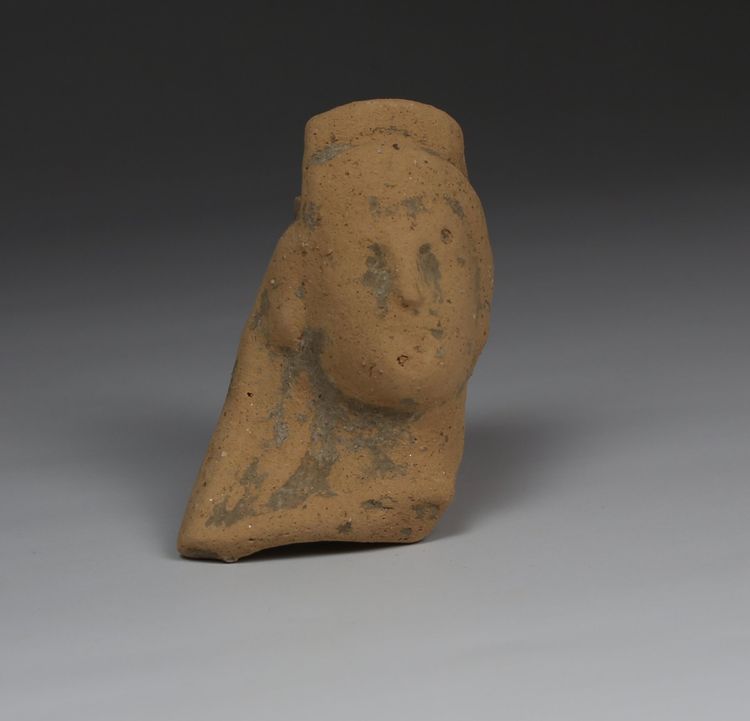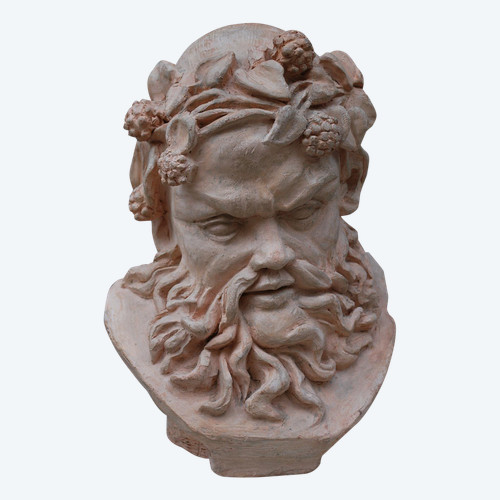This description has been translated and may not be completely accurate. Click here to see the original
Fragment of a terracotta head from the Greek period (4th century BC), preserved in a fine archaeological condition.
The piece presents a schematized face with still-legible volumes (full cheekbones, pronounced nasal bridge), topped by a cylindrical cap or smooth diadem.
The matte, sandy surface bears subtle calcareous concretions and traces of a grey-green slip, confirming ancient burial and prolonged terrestrial contact.
The back is concave, typical of a hollow moulding intended to reduce weight; the lower lip shows a small ancient chip, stable and non-progressive.
These “imperfections” are in fact signs of authenticity: the homogeneous wear, micro-pits of erosion, and firing irregularities attest to an ancient handmade production, free of any modern retouching.
Characteristics
-
Object: Head (independent fragment)
-
Material: Terracotta with ochre clay and visible inclusions
-
Culture: Greek
-
Period: 4th century BC
-
Dimensions: approx. 64 × 46 mm
-
Condition: Good; period wear, minor edge chipping, mineral concretions, original hollowed back
-
Provenance: Former English private collection, acquired between 1980 and 1995
-
Certificate: Supplied
Historical Context
In the 4th century BC, Greek coroplastic workshops produced, by moulding and hand-finishing, heads and protomai intended for domestic votive use or small sanctuaries.
The refined treatment of features, cylindrical headgear, and fine clay with coarse inclusions point to workshops emphasizing expressive presence over individualized portraiture.
Such heads served as offerings of piety and as decorative ornaments, often presented independently or attached to bodies or stelae.
Formal and Material Analysis of the Specimen
-
Modelling: Strong, frank volumes (rounded chin, high cheeks), nose formed by fingertip pressure; deliberate reduction of ocular details in keeping with a votive aesthetic.
-
Headdress: Clear circular band, compatible with a kalathos or bonnet, typical of 4th-century glyptics and coroplastic art.
-
Technology: Ochre clay, evenly fired; hollow back indicating moulding followed by manual retouching; natural firing micro-cracks, non-structural.
-
Patina: Diffuse calcareous deposit, soft abrasion on reliefs, absence of harsh cleaning; authentic surface, not “refreshed”.
-
Integrity: Self-contained fragment; old break line at the base; perfectly stable on a flat surface or display mount.
Cultural Value
A sober yet eloquent piece, ideal for study collections or decorative display highlighting the poetic materiality of antiquity.
Its patina, economy of form, and volumetric density make it a didactic testimony to the Greek coroplastic workshops of the 4th century BC, where craftsmanship and devotion were intimately intertwined.
Traceability & Guarantees
Provenance: Former English private collection, acquisitions between 1980 and 1995.
Transaction compliant with current heritage and art trade regulations.
Certificate of authenticity issued under the buyer’s order number.
Expert Report
Official typological identification:
Mould-made terracotta head, Greek coroplastic art, 4th century BC, independent fragment (votive head/protome type).
Authenticity criteria:
Ancient coarse clay with visible inclusions; natural calcareous patina; coherent wear of reliefs; original concave back; no modern reworking visible.
Scientific & Museum References (typological parallels):
– Louvre Museum, Department of Greek Antiquities: collections of terracotta heads and protomai, 4th century BC (Boeotian and Attic coroplastic workshops).
– British Museum, Greek terracottas: votive heads with cylindrical headdress, 4th century BC.
(Parallels cited for typological context; not from this provenance.)
Indicative Bibliography:
– Higgins, R., Greek Terracottas, British Museum, 1969.
– Besques, S., Catalogue Raisonné des figurines et reliefs en terre cuite grecs, étrusques et romains (Louvre).
Ref: 20BIX1CZ9N
 Light stand, 17th century.
1.200 € EUR
Light stand, 17th century.
1.200 € EUR






























